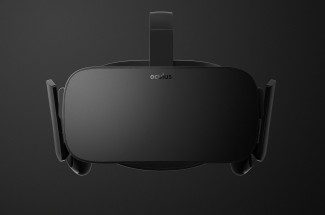E3 2015
 Oculus have demonstrated their 3rd major VR headset feature prototype at their Inaugural ‘Oculus Connect’ developer conference. It was the first time Oculus publicly emphasised a standing VR experience and the new headset’s 360 degree positional tracking allowed them to demonstrate this extremely effectively. It has since transpired that this headset actually represents the closest relative of Oculus’ first consumer VR headset, the CV1, as the company recently announced technical specifications for the long-awaited device.
Oculus have demonstrated their 3rd major VR headset feature prototype at their Inaugural ‘Oculus Connect’ developer conference. It was the first time Oculus publicly emphasised a standing VR experience and the new headset’s 360 degree positional tracking allowed them to demonstrate this extremely effectively. It has since transpired that this headset actually represents the closest relative of Oculus’ first consumer VR headset, the CV1, as the company recently announced technical specifications for the long-awaited device.
See Also: Oculus Reveals Recommended Rift Specs and Confirms CV1 Resolution

Valve have by now of course joined the fray too—and how! They took GDC 2015 by storm announcing and demonstrating their own entry into the virtual reality market—the HTC manufactured ‘Vive’ headset—the flagship device for their SteamVR platform. Along with their impressive Lighthouse room-scale laser tracking system, this was no half-arsed attempt at VR bandwagon jumping. The GDC demonstrations wowed everyone who tried them and for the first time it seemed Oculus had been ousted as the sole purveyors of high-end virtual reality. Importantly, Valve demonstrated solutions for both immersion (headset) and input (SteamVR controllers powered by Lighthouse), offering a vision of a complete VR consumer package.

Oculus meanwhile, whilst having long acknowledged the importance of dedicated VR input solutions, have yet to talk about what they intend to offer. This is very likely to change over the next couple of weeks however, with hopes that Oculus’ VR input revelations may well come at their recently announced Pre-E3 ‘Step Into the Rift’ event in San Francisco on the 11th of June. Their acquisition of computer vision and input specialist Nimble VR late last year and their more recent purchase of 3D environment mapping company Surreal Vision may give us a hint as to where Oculus’ plans for input lie in the medium to long term, but it’s unlikely we’ll see solutions based around those technologies any time soon. Although it is likely that we’ll see the fruits of an older partnership, Oculus’ acquisition of Carbon Design; the team behind the original Xbox 360 controller have some impressive industrial design chops and, although we’ve heard little from the group since the original announcement, their hand in designing Oculus’ consumer grade hardware is likely to extend to both headset and input peripherals.
See Also: Oculus Rift CV1 High Res Photos Suggest a Lighter, More Comfortable Headset

We shouldn’t forget of course that mobile virtual reality has made huge strides in the last 12 months too. With Samsung launching the Oculus powered Gear VR last year, astounding many by demonstrating the high-levels of immersion possible in a device powered by a mobile phone. Google too have had enormous success with their Cardboard initiative, with their recent I/O conference dominated by virtual and augmented reality technology. There’s no doubt that both players see a long term future in virtual reality and are beginning to invest heavily in its future.
Three Years is a Long Time in VR
Within the next 12 months we’ll see the release to market of at least three major VR systems. Valve boldly committed to not only get their Vive Developer Edition into creator’s hands ASAP and they recently quite literally delivered on that promise. They’re adamant they’ll also be the first company to market with a desktop consumer VR system as they target a holiday release window for the Vive. Oculus meanwhile have finally announced that they intend to get their CV1 into consumer homes by the close of Q1 2016 with Sony hot on their heels with Project Morpheus arriving in Q2.
So, the stage is set for a retail virtual reality face off the likes of which we’ve never seen before or even dared imagine just three years ago. Few could have predicted VR would enjoy such a meteoric rise in that time, and despite some delays along the way, we should keep in mind that less than three years ago the technology was a painful joke to most. Now, it’s poised to change everything.
It’s been a privilege to have helped journal VRs incredible history thus far here at Road to VR. But frankly, we’re even more excited about the future of VR now than we’ve ever been. We’ll be at E3 2015 to continue in our commitment to bring you the latest in virtual reality news direct from the show floor.
If you’re at E3 this year and have something cool and VR related to share with us, drop us a line at info@roadtovr.com and we’ll try to line up a meeting.







